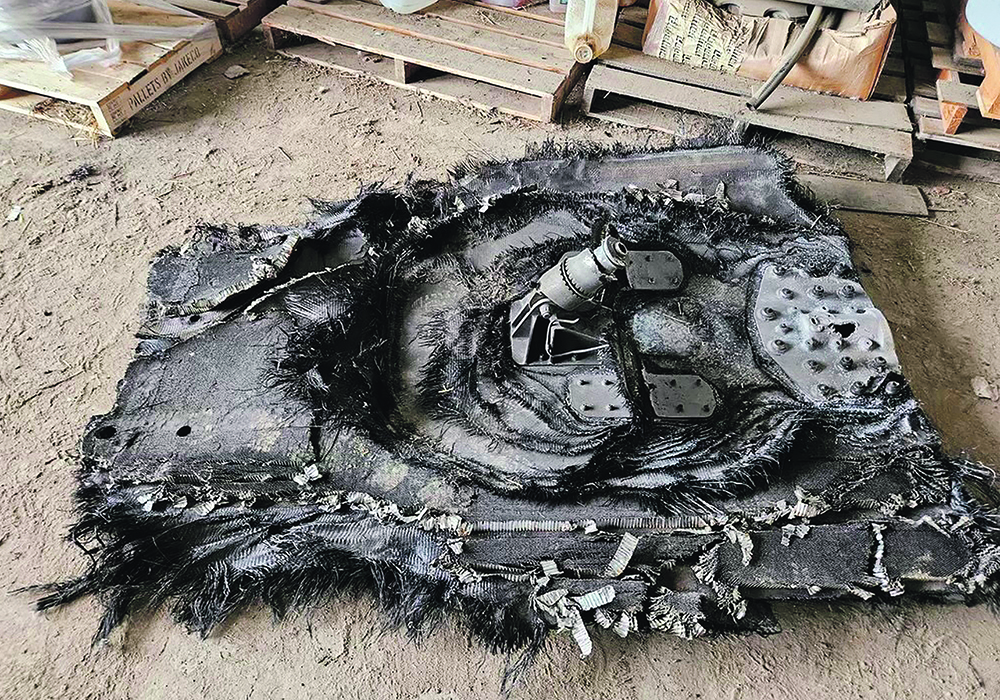Astronomer says more pieces of a Space X rocket that fell to Earth last winter are likely out there if farmers look for them
REGINA — Pieces of a SpaceX rocket found in a Saskatchewan farmer’s field raise questions about safety and who owns the debris.
Barry Sawchuk, who farms near Ituna in east-central Saskatchewan, said he and his son were out looking at fields prior to seeding when they spotted what they thought was garbage.
“We thought it was just a piece of plastic. We go over to pick it up and it wasn’t that,” he said.
A closer look found two pieces of charred debris, one of them 98 pounds and the other 21 lb. Sawchuk said they are among the more unusual items he has found in his fields.
Read Also

Canola oil transloading facility opens
DP World just opened its new canola oil transload facility at the Port of Vancouver. It can ship one million tonnes of the commodity per year.
He was able to see some serial numbers on the pieces and asked University of Regina astronomer Samantha Lawler to help identify where it could have come from. There had been no reported plane crashes, so they knew that wasn’t the source.
Lawler contacted a colleague at Harvard University who compiles a public database of launches and re-entry and confirmed that a SpaceX Crew Dragon trunk had re-entered on Feb. 26. It fell to Earth travelling between 160 and 200 km-h.
“Can you imagine if it ever happened in the city?” Sawchuk said.
“It would definitely rearrange the shingles on a house.”
Lawler called the situation terrifying.
“The thing that worries me is that SpaceX always claims that it all burns up in the atmosphere, none of it is going to make it to the ground. But Barry found this 100 lb. piece. Imagine if that landed in Regina or Toronto? That would have killed someone. It’s terrifying that it’s not fully disintegrating as they claim,” she said.
She also said there has to be more out there. The debris fell in a straight east-west line from the Ituna area and some other small pieces have been found.
Sawchuk said he’d like to sell the pieces he found to raise money for the community, which is building a new skating rink.
However, Lawler said space law experts have told her responsibility and ownership are grey areas.
“The only rules that apply to space objects is the outer space treaties, which were written in a time when the only launching entities were governments,” she said.
“It’s not even clear if these rules apply to private companies.”
Lawler said new international regulations for all objects going into orbit are required because this type of situation is going to become more common.
“The density of satellites over southern Canada is the highest in the world just because of the orbits that Starlink and other constellations are using,” she said.
“There will be more American space junk on Canadian private property and we need to know what to do about this.”
Meanwhile, someone claiming to be from SpaceX contacted Sawchuk and told him to send the pieces back to the company. Lawler said SpaceX should pay for the transport if they want the pieces, and “he should definitely request that SpaceX gives a healthy donation to the Ituna skating rink.”
She intended to visit Sawchuk last weekend to examine the pieces.
“Scientifically this is super useful because SpaceX is notorious for not sharing information about what they make their satellites out of, what kind of stuff they’re burning up in the atmosphere, what kind of pollution this is making, and so it’s really scientifically useful to have a piece of it to study,” she said. “This might be the only way that scientists can get a hold of it, even if it’s dubious legalities.”
Farmers who find pieces of space junk can get in touch with Lawler at the U of R. She said this debris is not dangerous or radioactive.
In 1978 a nuclear-powered surveillance satellite from the former Soviet Union crashed in the Northwest Territories and spread radioactive debris over 124,000 sq. kilometres, including into Alberta and Saskatchewan.


















